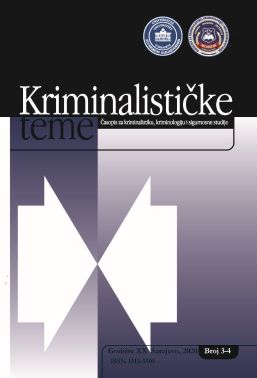Opis počinitelja krivičnog djela u okviru radnje saslušanja svjedoka: da li kvantitet uvijek znači i kvalitet?
DESCRIPTION OF THE PERPETRATOR WITHIN EYEWITNESS TESTIMONY: DOES QUANTITY ALWAYS MEAN QUALITY?
Author(s): Adnan Fazlić, Irma Deljkić, Eldan MujanovićSubject(s): Criminal Law
Published by: Fakultet za kriminalistiku, kriminologiju i sigurnosne studije Univerziteta u Sarajevu
Keywords: description of the perpetrator; eyewitness statement; eyewitness testimony; eyewitness identification; criminal investigation science;
Summary/Abstract: Reason(s) for writing and research problem(s): The inspiration for this paper is reflected in the fact that eyewitness accounts are one of the most common types of evidence in criminal proceedings, while eyewitness testimony mostly is an essential part of criminal investigation. Additionally, the lack of scientific papers on this topic in Bosnia and Herzegovina served as the inspiration. Aims of the paper (scientific and/or social): The aim of the paper is to analyse prominent scientific literature that considers the quantity and quality of eyewitness' description of the perpetrator, to put their results into the investigative context of eyewitness testimony, and to formulate research questions for the future scientific research. In addition, the paper aimed to extend the body of knowledge on this topic in criminal investigation science in Bosnia and Herzegovina. Methodology/Design: Document analysis of the scientific literature on the quantity and quality of description of the perpetrator. Research/paper limitations: The paper does not include the analysis of all relevant scientific literature on the quantity and quality of eyewitness statements, but the analysis of the most prominent scientific literature. Results/Findings: The results indicate that the description quantity is not an indicator of the description quality, as well as the quantity and quality of description are not an indicator of accurate eyewitness identification. General conclusion: Despite the quantity and quality of description do not influence the results of eyewitness testimony (and eyewitness identification), it is evident that findings of the paper have certain implications for the preparation, planning and carrying of these actions, as well as for the assessing the reliability and accuracy of eyewitness testimony. Research/paper validity: The paper validity lies in the fact that there is the lack of scientific papers which studiously discussed these topics in Bosnia and Herzegovina.
Journal: Kriminalističke teme – Časopis za kriminalistiku, kriminologiju i sigurnosne studije
- Issue Year: XX/2020
- Issue No: 3-4
- Page Range: 57-76
- Page Count: 20
- Language: Bosnian, Croatian, Serbian

